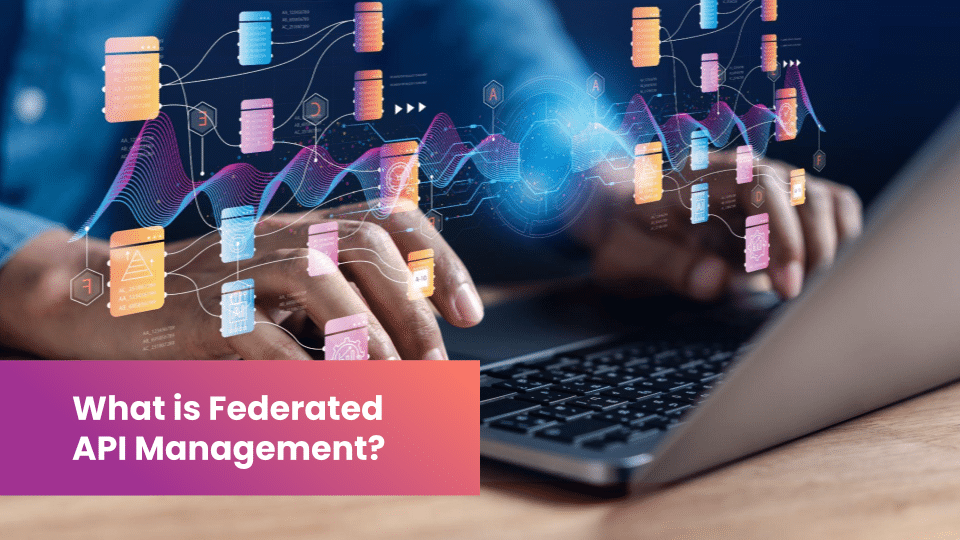With the continued expansion of technology, APIs are spread across public clouds, private data centers, and SaaS platforms. Managing these dispersed APIs can become overwhelming without proper oversight. Ensuring their security, monitoring their performance, and maintaining visibility across environments requires a cohesive strategy.
Federated API management is an approach that uses centralized governance for distributed APIs. By using a uniform platform and policy-driven tools, teams can oversee internal and external APIs, implement security measures, and simplify access management without disrupting operations.
This blog helps you learn about the capabilities of federated API management platforms and how they ensure consistent governance.
What Is Federated API Management?
Federated API management provides a governance model that combines centralized oversight with decentralized execution. It allows teams to establish policies, enforce standards, and define security protocols while allowing connected teams or business units to manage and deploy their APIs independently. Its key features are:
- Decentralized Governance: Allows teams to manage APIs within the parameters of organization-wide policies for security, quotas, and compliance.
- Centralized Dashboards: Creates dashboards that consolidate analytics, monitoring, and reporting. This approach provides a clear view of API traffic and usage across environments, enabling efficient observability, alerting, and troubleshooting.
- Flexible Deployment Models: Supports APIs residing in multi-cloud, hybrid, or on-premises environments while providing a consistent management interface.
- Policy Standardization with Local Adaptation: Implements organization-wide policies that establish baseline data security, availability, and governance standards, while localized adaptations address regional regulations and team-specific needs.
- Efficient Cross-Team Collaboration: A centralized repository for API definitions, documentation, and best practices minimizes duplication and promotes innovation across distributed teams with collaboration tools.
- Adaptable Architecture: Loose coupling between the management layer and APIs ensures stability by preventing cascading failures. It also supports custom extensions and integration with external systems.
- Granular Access Control: Implements role-based access control, OAuth2, and API keys to authorize consumer access while applying rate limits to prevent misuse. Fine-grained controls secure and monitor API consumption throughout the organization.
Federated vs. Siloed vs. Centralized API Management
Companies have three main ways to manage their APIs: centralized, federated, or siloed. Centralized models give one team complete control, ensuring consistency but potentially slowing down development. Federated models distribute ownership while maintaining some central guidelines, balancing freedom with structure. Siloed models allow each team to manage its APIs, offering maximum flexibility but risking inconsistency and chaos. Choosing the right model depends on your company’s priorities, finding the balance between control and agility.
Federated API Management
Federated API management balances centralized governance with distributed ownership. Key attributes include:
- Distributed Ownership: Departments manage their APIs while adhering to organizational standards.
- Standardized Governance: Policies, security, and tooling are set centrally for consistency.
- Flexible Deployment Options: APIs can operate across hybrid, multi-cloud, and on-premises environments without sacrificing control.
- Collaborative Development: Teams can innovate within a standardized framework.
Siloed API Management
In siloed API management, teams operate independently without cross-team coordination. Characteristics include:
- Limited Cross-Team Communication: Each department manages its APIs without centralized oversight.
- Inconsistent Standards: Standards vary between teams, leading to inefficiencies.
- Reduced Visibility: Lack of centralized monitoring creates blind spots.
- Potential Security Risks: Inconsistent practices can introduce vulnerabilities.
Centralized API Management
Centralized API management consolidates control under a single team, prioritizing strict governance and uniformity. Features include:
- Strict Governance: A central body oversees all policies, configurations, and security measures.
- Uniform Configuration: Ensures consistency across the API portfolio.
- Slower Innovation Cycles: Limited autonomy slows down development.
- Reduced Team Flexibility: Teams have less control over API decisions.
Advantages of Implementing Federated API Management
API federation management allows teams to own and operate their APIs independently while adhering to centralized governance policies. This approach boosts agility while maintaining consistency. Key benefits include:
- Reduces Central Team’s Operational Burden: Teams handle API operations independently, following standardized best practices. This approach eliminates the need for a central team to oversee manual configurations, freeing them to focus on higher-priority tasks.
- Provides Architectural Freedom: Enables departments to deploy APIs based on their choice of technology, geographical needs, or compliance requirements, avoiding vendor lock-in.
- Minimizes Configuration Overhead: Simplifies onboarding of new APIs through infrastructure-as-code deployments and ready-to-use templates for security, rate limiting, and other configurations.
- Improves Development Speed: Self-service portals, local API control, and pre-built components streamline the API development lifecycle, reducing time to market.
- Ensures Consistent Security Standards: Establishes organization-wide policies for authentication, encryption, and vulnerability detection while allowing localized adjustments to meet regional compliance.
- Encourages Collaborative Development: Centralized portals, shared resources, and reusable API components enable efficient teamwork and spread best practices across teams.
Looking for unified API Management? Go with a leader. Gartner® positioned Boomi as a Leader in the 2025 Magic Quadrant™ for API Management
Potential Challenges in Federated API Management
A core premise of API federation management is centralized governance with decentralized ownership. Ensuring various departments consistently adhere to directives, standards, and policies across distributed APIs is essential but can be difficult. Let’s have a look at the challenges and potential solutions:
- More Work for Central Teams: Overseeing APIs across diverse environments increases the volume of data and responsibilities for governance teams. Without automation or efficient design, central governance teams can quickly become overwhelmed.
Solution: Automate policy enforcement, monitoring, and remediation processes to reduce manual workload. Intuitive dashboards and tools can further simplify tracking and coordination. - Complex Setup: Creating a reliable management layer with excellent integrations requires specialized knowledge of API gateways, security protocols, and infrastructure orchestration. Poorly designed systems lead to unreliable architectures.
Solution: Use cloud-native services and simplified middleware to speed up setup and reduce custom software requirements. - Steeper Learning Curve: Adopting federated API management introduces additional infrastructure considerations compared to traditional centralized systems. Misconfigurations during the transition can disrupt production environments.
Solution: Implement gradual onboarding with training materials, staging environments for testing, and self-service tools to guide teams through the process while minimizing risks.
Manage Your APIs Better With Boomi
Federated API management offers significant strategic advantages for modern software ecosystems. It provides the perfect balance of centralized governance and decentralized flexibility. With a unified control plane, you can manage your organization’s complex, distributed APIs while avoiding vendor lock-in or cascading failures.
Boomi’s API Control Plane simplifies the challenges of API sprawl. It delivers a single platform to discover, govern, and monitor APIs at scale, ensuring consistency, security, and visibility across all API environments. Key features include:
- Centralized API Discovery: Boomi makes it easy to discover all APIs within your organization from a single dashboard, improving visibility and control over shadow APIs.
- Cross-Gateway Management: The platform enables you to manage APIs across multiple gateways, such as Apigee, AWS, and Azure, without locking you into a single vendor solution.
- Comprehensive API Audits: The solution allows you to conduct security and quality audits to ensure compliance with standards and detect vulnerabilities.
- Unified API Governance: With Boomi, you can enforce consistent policies across all APIs, improving security, compliance, and operational efficiency.
- Developer Portal for Better API Accessibility: It provides a drag-and-drop interface that makes API documentation and developer adoption easier.
- API Usage Insights: Boomi gives detailed insights into API performance and consumption, helping you identify dormant or underutilized APIs.
- Manage Unsecured APIs: Boomi reduces the risks associated with shadow APIs by identifying and securing unmanaged endpoints across the environment.
- Customizable Policies: With Boomi, you can configure reusable security, traffic management, and access control policies to ensure API safety.
See Boomi’s federated API management in action through an interactive product tour.


 English
English 日本語
日本語